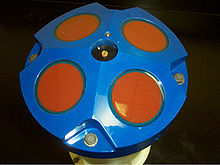Ultrasonic Doppler Profile Flowmeter


Today's most important measuring device for flow and flow measurement is the ultrasonic Doppler profile flow meter ( English : Acoustic Doppler Current Profiler (ADCP) ), an active sonar that measures the Doppler frequency shift of the reverberation of scattering bodies in the water (mainly plankton and suspended matter ) to determine the local flow velocity. The device is equipped with three to five independent transducers ( transducer equipped), wherein the opposing pairs each form. Each pair of transducers measures the horizontal movement in one direction, the vertical movement is measured by both in parallel. For this purpose, the devices emit sound impulses in the range of 500 kHz – 10 MHz at fixed time intervals. The backscattered signals are received again between the pulses. Over their runtime, these allow an assignment to the relative distance to the transducer. Depending on the design and configuration, the devices can measure the three-dimensional water speed in different depths. With the help of the relationship:
where is the Doppler frequency shift measured by the device and the frequency of the transmitted signal, the relative velocity u of the body of water can be calculated. In the case of autonomous devices, the measured speeds of the various layers are saved and can be read out later. The devices can also be installed in the plumb shaft of a ship. Then the relative speed between the body of water and the ship is measured (moving boat method). The measurement results can be analyzed at any time using a laptop or computer. If the bottom of the water is within the range of the ADCP, it is possible to calculate the absolute water speed of the individual layers below the ship using the relative speed of the bottom to the ship ( bottom track ).
Basically, the resolution of the measurement process is due to the reverberation uncertainty relation
limited, where the resolution of the flow velocity, the distance resolution , the speed of sound and the center frequency of the transmitted signal are. The higher the frequency, the better the achievable resolution and the shorter the length of the flow profile because of the frequency-dependent damping. The resolution can be increased with the help of a large transmission signal bandwidth compared to the reverberation uncertainty relation (broadband ADCP, BB-ADCP).
The Federal Institute for Hydrology (BfG) in Koblenz has developed AGILA evaluation software (named after the software developer Matthias Adler) for the uniform evaluation of ADCP measurement data. The software has meanwhile been established as a standard mainly in German-speaking countries. In addition, there are software solutions that further process the manufacturer-specific raw data and add additional evaluation parameters, such as B. suspended matter content, turbidity, etc. available.
If, in addition to the transducers for flow measurement, another transducer is directed vertically upwards (in the case of a system standing on the bottom of the water), it is possible to measure parameters such as wave height and wave period directly in addition to the flow profile.
See also: waterborne sound
Note on the use of the term ADCP
As mentioned above, ADCP can be read as an abbreviation for Acoustic Doppler Current Profiler , and is often used colloquially for flow profilers , regardless of the manufacturer, but is also a trademark of Teledyne RD Instruments, Rowe, SonTek and other companies.
Individual evidence
- ↑ Acoustic Doppler Current Profiler (ADCP) measurement equipment. TU Harburg, archived from the original on June 11, 2007 ; accessed on March 15, 2016 .
- ↑ RD Instruments (1987): "RD-MV Model acoustic doppler current profiler, Operation and maintenance manual"
- ↑ Luff, R. (1994): “Spread of passive, conservative substances in the North Sea, using a hydro- and thermodynamic long-term data set”, diploma thesis in oceanography at the University of Hamburg
- ↑ Flow measurement - ADCP - function and application. (PDF; 1.1 MB) Federal Institute for Hydrology, accessed on March 15, 2016 .
- ↑ Flow measurement - evaluation by software - AGILA and TIDE. Federal Institute for Hydrology, accessed on March 15, 2016 .
- ↑ Flow measurement - brief description of AGILA. (PDF; 0.3 MB) Federal Institute for Hydrology, accessed on March 15, 2016 .
- ↑ Nortek AWAC. Nortek International, accessed on March 15, 2016 (English): “Acoustic Surface Tracking (AST). The AST is basically echo-ranging to the surface with the vertically oriented transducer. The beauty of this method of measuring waves is that it circumvents the depth limits imposed by bottom mounted pressure and velocity measurements. "
- ↑ Product Survey - Acoustic Doppler Current Profilers. (PDF: 0.3 MB) RD Instruments, November 26, 2007, archived from the original on April 13, 2014 ; accessed on March 15, 2016 .
Web links
- Michael R. Simpson and Richard N. Oltmann: Discharge-Measurement System Using an Acoustic Doppler Current Profiler with Applications to Large Rivers and Estuaries. In: USGS Water-Supply Paper 2395. 1993, accessed on March 15, 2016 (English).
- Runoff and velocity measurements with ADCP. Institute of Water Management, University of Munich, accessed on March 15, 2016 .








